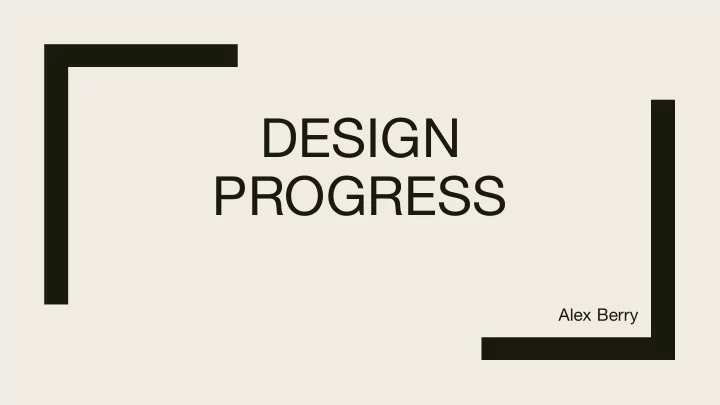

DESIGN PROGRESS Alex Berry
Inspirational typographers
My Design I really like geometric forms, bright contrasting colours, filled pages, basic shapes congregated into unusual patterns, varied font which overlaps and creates further meaning through its positioning. Archigram The modernist
Wolfgang Weingart Weingart was born in 1941 and is regarded as one of the most unconventional designers of the second half of the twentieth century. He breaks the generic rules and experiments freely. He had an open mind for technology and explored new design paths. In 1990, Wolfgang Weingart showed his own work for the first time in a comprehensive exhibition entitled WortZeichen, SchriftFelder, BildRäume (WordSigns, WritingFields, PictureSpaces) held at the Institute for New Technical Form (Institut für Neue TechnischeForm) in Darmstadt. He had interest in swiss typography to which he has altered and made it into a type of new wave, post-modern punk type – ‘weingart style’
“Weingart exhaustively churned out iterations, cut things up, replaced elements, changed the grid, changed the colours, changed the typeface weight, style, and point size, etc. He would develop a wealth of design options for one single brief, then cross analyse those options and pick the #1 best solution.” “I would argue that Weingart’s innovative way of working—with a conscious focus on iterative design process—has changed the way the world approaches design. In this way, his “remixing” process has fundamentally changed the way the world receives information via visual communication.” http://shillingtondesignblog.com/wolfgang-weingart-tbt/
This design has many attributes to which I would like to incorporate in my own work. The first being the deep bold helvetica font which has shapes erased out of it. I believe this gives the font a unique look which relates to the overall meaning and feel of the design. I also like that the main image design is split subtly into four parts, this gives it an abstract feel and the whole image gives off the most perfect post- modern vibe. The design is abstract and intricate, confusing to figure out and loaded with life.
Another feature from his work which I would like to incorporate and change around into my own is how he lowers the opacity of grey rectangles and places them over his bold type. Some designers would say that font needs to stay in one size in order for the design to look proffesiona and good. Here we see that the font varies in all sizes. The biggest at the top, the smallest in the middle, and the medium at the bottom. A complete disaster to some but to me it interests me.
His design process includes: Deconstruction/remixing Extrapolation (consciously churning out variations on the design) Juxtaposition (setting those versions next to one another) Cross- analysation (analysing which option is better when they’re next to each other) The next image is great because it really shows what post- modern poster work should look like in my opinion. Instead of taking out the grids used for alignment in the design, they are partially kept in and also not just one grid but a range of them. Along with this there are added drawn images and photography in black and white made to look like they have been stuck down. I would like to incorporate this into my design work as I find it aesthetically pleasing. I love the dots around the left side of the page, I would like to mix these around my type in a poster I create. I also love the contrast of black and white mixed with color. The font is also powerful, very bold and in capitals, again breaking the rules and not aligning, something I would like to do with my font.
Rosmari Tissi (b. 1937) The ways to describe the work produced by these typographers would be playful and disorganized. The work has a ‘playful sense of form and unexpected manipulation of space’. I really enjoy the mix mash of colours used and the lay text over laps and varies in size.
There are many similarities to that of the work of Wolfgang Weingart. As shown above Tissi uses grids and blocks of colour behind words. I also enjoy that she has combined serif and sans serif type into one letter.
I like the gradient being used here in some of the shapes whereas others have block colour. I like that only two scales of colour are used throughtout the piece and the grids inside the letters. I like that the piece has contemporary pop culture in it such as the polka dots but also resembles ancient symbols such as pyramid and the use of shapes.
Bib/reference Weingart, W., Weingart, the, T. of, Wolff, K., Wolff, K. and Schelbert, C. (2000) Weingart: Typography - my way to typography - retrospective in Ten chapters with thoughts by Paul Rand . Baden, Switzerland: Lars Muller Publishers http://www.aisleone.net/2014/06/04/rosmarie-tissi/
Recommend
More recommend